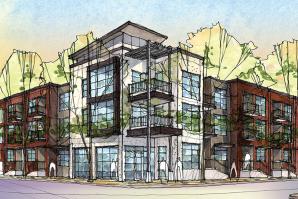Construction executive Paul Cunha bought a new car last year and has been rolling up the miles like a travelling salesman.
“I’ve had the car for 50 weeks, and I’ve driven it 30,000 miles. And I’m not driving to New York,” says the Sacramento-based vice-president of general contractor JR Roberts/Deacon.
He does, however, spend a lot of time driving to the Bay Area. He says, “It’s where the jobs are.”
Cunha has plenty of company on the freeway, as construction executives, project managers, architects and engineers are turning to Bay Area clients to offset the recession-laden economic doldrums of Sacramento.
The Capital Region construction industry lost 4,100 jobs in 2012, according to government data. Some industry experts disagree with the estimate but concede that the segment experienced little to no job growth last year, at best.
“The commercial sector pretty much died, and without the housing, there weren’t any schools being built,” says John Harvey of the structural engineering firm Buehler and Buehler.
There wasn’t much need to build new office buildings either when 22 percent of the available floor space in the region was empty.
By contrast, construction in the Bay Area is creating a new gold rush, fueled by public and private projects in transportation, medical and education facilities and stratospheric hiring in the high-tech industry.
Housing in San Francisco has long been scarce compared to the demand. Adding more than 40,000 high-tech workers who prefer to live in the city and commute to Silicon Valley increased the imbalance. Fueled by low interest rates and a pipeline of entitled projects, housing construction is at a 5-year high and four times greater than its annual average.
The high-tech industry has also gobbled up formerly vacant office buildings. More than a dozen companies, from Google and Apple to Pinterest and Airbnb, have transformed the midsection of Market Street into Tech Central the way financial firms define Wall Street. Many of those firms fill entire city blocks. Fed by a gush of 9 million square feet of office space in the permitting pipeline, cranes for high-rise construction dominate the skyline like oil derricks in West Texas.
According to a recent Urban Land Institute survey, San Francisco is the nation’s top market for investment, development and housing.
“It’s an 80-million-square-foot market in four and a half square miles, and I think they have 39 cranes in the air,” says Wyatt Jones, president of Airco Mechanical.
Jones can see many of those cranes from his new satellite facility on Treasure Island, where Airco Mechanical has set up shop to work on the Bay Area ’s largest public works project, the new Transbay Transit Center. The $4 billion project, considered the “Grand Central Station of the West,” will connect BART, Caltrain and buses from 11 transit agencies and accommodate 100,000 travelers a day when it opens in 2017.
Jones’ firm is building a geothermal heating system for the terminal, more complicated than your typical plumbing project. Like many Sacramento companies, Jones has always had projects in the Bay Area, “but nothing like this,” he says. Jones shares a belief with many of his colleagues: Sacramento is home, but much of his future is in the Bay Area.
“The backbone of the company is still in Sacramento,” says Jones. “But in 2013 we made a commitment to the Bay Area for the long view,” he adds, estimating that as much as 75 to 80 percent of the company’s future revenue will come from the Bay Area.
Currently, the company has about a dozen projects in the San Francisco region, including a new lab building for UC San Francisco, several office buildings and two hotels.
The new satellite facility allows Airco Mechanical to fabricate on-site while keeping the engineering, administrative and management staff of 50 people in Sacramento. Like many construction executives, Jones sees Sacramento as an extension of the Bay Area. “We’re fortunate in Sacramento that San Francisco is only 80 miles away and within arms’ reach,” Jones says. “If this market were in Phoenix or Seattle it wouldn’t be as helpful because it would be too hard to reach.”
Harvey, of Buehler and Buehler, agrees that Sacramento’s proximity to the Bay Area makes it convenient to work on projects there. “I take Amtrak as much as possible,” taking advantage of WiFi to work while other commuters are stuck in traffic, he says.
But the building boom is not limited to the central city. Principal James Fitzgerald had so many projects in the East Bay, from office buildings to data centers, that last year he established a satellite office in Walnut Creek for Market One Builders, a general contracting firm staffed by a project manager with extensive experience in the Bay Area. It was a strategic decision to nurture relationships with existing customers. “We do a lot of repeat business down there,” Fitzgerald says. “We didn’t open an office and then decide what to do with it.”
Many Sacramento companies have discovered that their Bay Area clients prefer a local presence, even if it’s just a meeting room and a local area code. “We have so many clients who told us that they liked us but were concerned we were so far away,” says Carl Lubawy, principal in the architectural firm of LPAS, whose recent projects include a million-square-foot building for Apple and community college expansions in San Jose and San Mateo.
To provide that personal touch, LPAS leased an office in San Francisco last year. It is nothing more than a conference room with a phone, but it provides space to meet with clients a couple of days a week, while the bulk of the company’s design work is still done in Sacramento. “We were trying to keep our core staff and had to expand to new areas to find business,” says Lubawy. “We were fortunate enough to have clients in the Bay Area.”
Another of the region’s large construction projects is a $1.5 billion expansion of UC San Francisco Medical Center in Mission Bay. The 6-story project, which will add 878,000 square feet of treatment space for children, women and cancer patients, fills up two city blocks and is managed by a team of roughly 100 architects, engineers and contractors in a command center in downtown San Francisco.
That kind of construction primes other development in the region throughout the Peninsula and East Bay, from medical buildings to residential and retail. That’s the bread and butter for Rick Poipao, president of RCP Construction, who expects to double his Bay Area projects next year to offset an anemic local market, where over the last few years, “breaking even was the new success story,” he says.
Like many other contractors, working in the Bay Area is not new for Poipao. “There’s a perception that companies from Sacramento are more competitive because of lower labor costs,” he says. But the Bay Area is more important to his bottom line than ever. “If we were solely a Sacramento company, we’d have to scale back. The overhead would be burdensome.”
During his 30,000-mile-a-year commute, Cunha watches the Bay Area grow. “We just finished a hotel down the street from Apple’s headquarters. I see high-tech Gen X and Gen Y kids in jeans and flip flops waiting on the street corner for the WiFi-equipped company commuter bus,” says Cunha, whose firm recently completed the nation’s largest Premium Outlets mall, a $50 million project in Livermore, and opened a new phase of housing in Santana Row, one of the region’s swankiest residential projects, where some units rent for $10,000 a month.
“We’re doing work here,” said Cunha, whose local portfolio includes hospital and retail projects. “But Northern California has been quiet because we don’t have the job creation. When the jobs come back, the work will come here.”
Recommended For You

Putting the Fab in Pre-Fab
Modular construction cuts construction and energy costs
The final stages of construction at a trend-setting apartment project in San Francisco’s SoMa neighborhood, known by its address at 38 Harriett St., largely resembled a life-sized game of Tetris.

The Plight of CADA
Where goes the neighborhood?
Three years ago, Gov. Jerry Brown pulled the plug on local government redevelopment agencies and the estimated $5 billion a year they spend rebuilding inner cities to combat urban blight.



